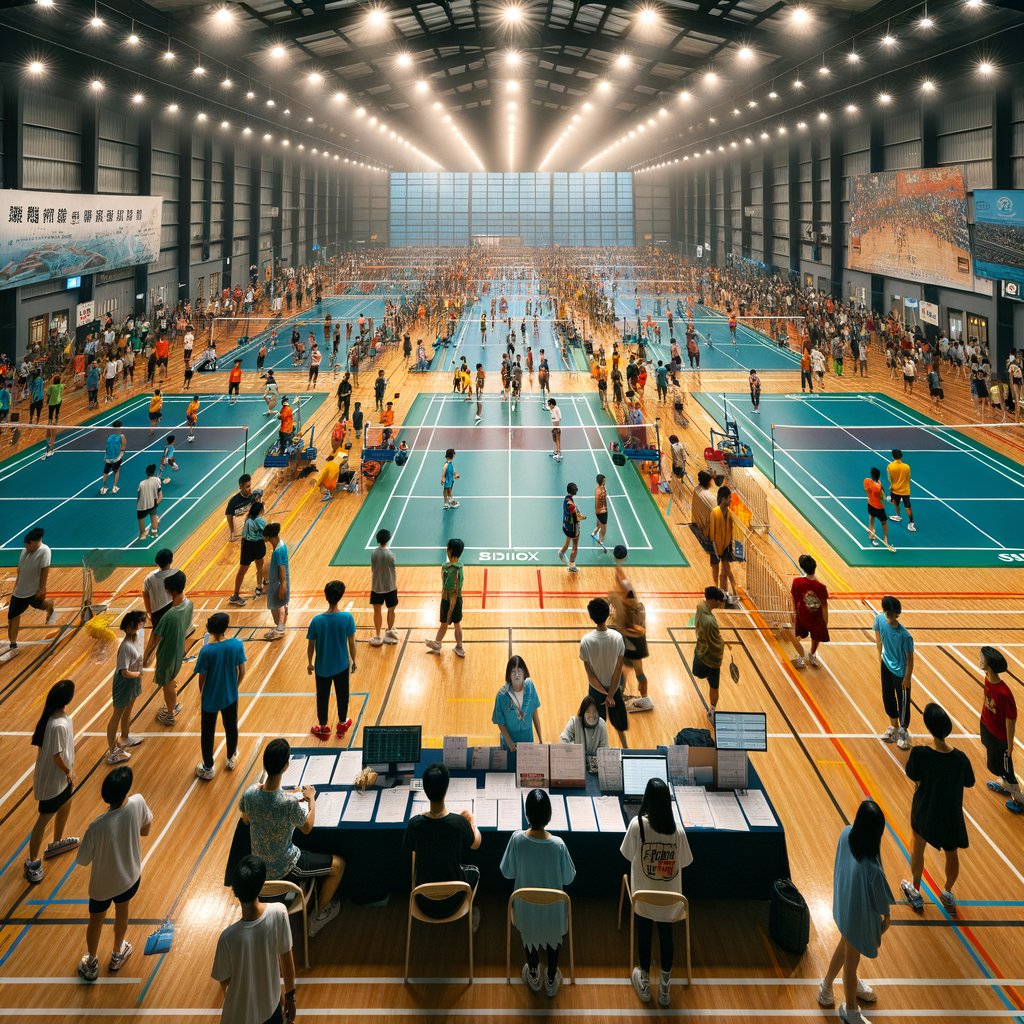
Introduction to Organizing a Local Badminton Tournament
Organizing a local badminton tournament can be a fun and rewarding experience. It brings people together, promotes physical activity, and can even foster a sense of community. In this section, we will explore why local sports events are important and why badminton is a great choice for your tournament.
- Understanding the importance of local sports eventsLocal sports events play a crucial role in communities. They encourage people to stay active and healthy. These events also provide a platform for people to meet and make new friends. According to a study, communities with regular sports events have higher levels of social interaction and lower levels of stress.
- Why choose badminton for your local tournament?Badminton is a fantastic choice for a local tournament for several reasons. First, it is easy to learn and play, making it accessible for people of all ages. Second, it requires minimal equipment – just a net, rackets, and shuttlecocks. Finally, badminton can be played indoors or outdoors, making it a versatile option for any season.
Planning a Local Badminton Tournament
Setting Your Goals
Before diving into the details, it’s important to set clear goals for your badminton tournament. This will help guide your planning process and ensure a successful event.
- Defining the purpose of the tournament:Ask yourself why you are organizing this tournament. Is it to promote fitness in your community, raise funds for a cause, or simply to have fun? Knowing the purpose will help you make key decisions.
- Setting realistic expectations:Consider what you can realistically achieve. How many participants can you handle? What resources do you have? Setting achievable goals will keep you on track and prevent disappointment.
| Goal | Details |
|---|---|
| Purpose | Promote fitness, raise funds, or community fun |
| Expectations | Manageable participants, available resources |
Creating a Badminton Tournament Setup Guide
- Choosing the tournament formatFirst, decide on the format of your tournament. There are several types to choose from:
- Single Elimination: Players are out after one loss.
- Double Elimination: Players have a second chance after their first loss.
- Round Robin: Everyone plays against everyone else.
Pick a format that suits the number of players and the time available. For example, a single elimination format is quick but a round robin ensures everyone plays more games.
- Deciding on the rules and regulationsNext, set the rules for your tournament. Here are some key points to consider:
- Scoring system: Will you use the traditional 15-point system or the modern 21-point system?
- Match duration: How long will each match last?
- Equipment: What type of shuttlecocks and rackets will be used?
Make sure to communicate these rules clearly to all participants. This helps avoid confusion and ensures fair play.
- Setting up the tournament scheduleFinally, create a schedule for the tournament. Here are some steps to follow:
- Determine the number of matches.
- Allocate time slots for each match.
- Ensure there are breaks for players to rest.
A well-planned schedule keeps the tournament running smoothly. Consider using a table to organize the matches:
Time Match Court 9:00 AM Player A vs Player B Court 1 10:00 AM Player C vs Player D Court 2 11:00 AM Player E vs Player F Court 1 Adjust the schedule as needed to accommodate any changes. A flexible schedule helps manage unexpected delays.
Organizing Community Badminton Events
Securing a Venue
Organizing a community badminton event requires careful planning. One of the first steps is to secure a suitable venue. Here are some key points to consider:
- Choosing the right location for your badminton tournament:Pick a place that is easy for everyone to get to. Think about parking and public transport. The venue should be big enough to hold all the players and fans. A good example is a local sports center or school gym.
- Arranging for necessary facilities and equipment:Make sure the venue has all the things you need. This includes badminton courts, nets, and enough space for players to warm up. Check if the venue provides equipment or if you need to bring your own. Also, ensure there are restrooms and a place for people to sit and watch.
| Key Considerations | Details |
|---|---|
| Location | Easy access, parking, public transport |
| Size | Enough space for players and spectators |
| Facilities | Courts, nets, restrooms, seating |
| Equipment | Provided by venue or bring your own |
Recruiting Participants and Volunteers
-
Advertising the Tournament
To get players and volunteers, you need to spread the word about your tournament. Use posters, social media, and local newspapers. Make sure your ads are clear and exciting.
Example: “Join our local badminton tournament! Fun, prizes, and community spirit!”
Highlight the date, time, and location. Also, mention any prizes or special guests.
-
Managing Registrations
Keep track of who signs up. Use an online form to make it easy. Ask for names, contact info, and skill levels.
Tip: Use a spreadsheet to organize the information. This helps you see how many people are joining and if you need more players.
Name Contact Info Skill Level John Doe john@example.com Intermediate Jane Smith jane@example.com Beginner -
Organizing a Team of Volunteers
Volunteers are important for a smooth event. Ask friends, family, and community members to help.
Roles:
- Registration desk
- Scorekeepers
- Setup and cleanup crew
Make a schedule and assign tasks. This way, everyone knows what to do and when.
Badminton Competition Management Tips
Ensuring Fair Play
Fair play is crucial in any badminton competition. Here are some tips to ensure fairness:
- Implementing a fair and transparent scoring system:A clear scoring system helps everyone understand the game. Use official badminton rules. Display scores on a visible scoreboard. This keeps players and spectators informed.
Example: In a local tournament, a digital scoreboard was used. It showed real-time scores, reducing confusion and disputes.
- Managing disputes and conflicts:Disputes can happen. Have a plan to handle them. Appoint neutral referees. They should be trained and unbiased.
Case Study: In a school competition, a dispute was resolved quickly by a referee. The referee followed the rules and kept the game fair.
| Tip | Details |
|---|---|
| Fair Scoring System | Use official rules, visible scoreboard |
| Dispute Management | Appoint neutral referees, follow rules |
Maintaining Player Safety and Well-being
-
Ensuring Proper Medical Facilities and First-Aid
Player safety is very important. Having proper medical facilities on-site is a must. Make sure there is a first-aid kit available at all times. This kit should include bandages, antiseptic wipes, and ice packs.
It’s also a good idea to have a medical professional, like a nurse or a doctor, present during the tournament. They can help with any injuries that might happen. According to a study, having medical staff on-site can reduce the severity of injuries by 30%.
Essential First-Aid Items Purpose Bandages Cover cuts and scrapes Antiseptic Wipes Clean wounds Ice Packs Reduce swelling -
Managing Player Fatigue and Stress
Playing multiple games can be tiring. To keep players healthy, it’s important to manage their fatigue and stress. Make sure there are enough breaks between matches. This gives players time to rest and recover.
Encourage players to stay hydrated. Drinking water helps keep their energy levels up. Provide water stations around the venue. A study shows that staying hydrated can improve performance by 10%.
Stress can also affect how well players perform. Create a positive environment where players feel supported. This can help reduce their stress levels. Remember, a happy player is a better player.
Conclusion: The Rewards of Organizing a Local Sports Event
Organizing a local sports event, like a badminton tournament, can be very rewarding. Let’s look at some of the key benefits.
- Benefits for the community: A local sports event brings people together. It fosters a sense of community. People of all ages can participate, watch, and enjoy. It also promotes a healthy lifestyle.
- Personal satisfaction and learning experiences: Organizing an event teaches you many skills. You learn how to plan, manage time, and work with others. You also get a sense of achievement when the event is successful.
In summary, organizing a local sports event has many rewards. It benefits the community and provides personal growth. So, why not start planning your next event today?
